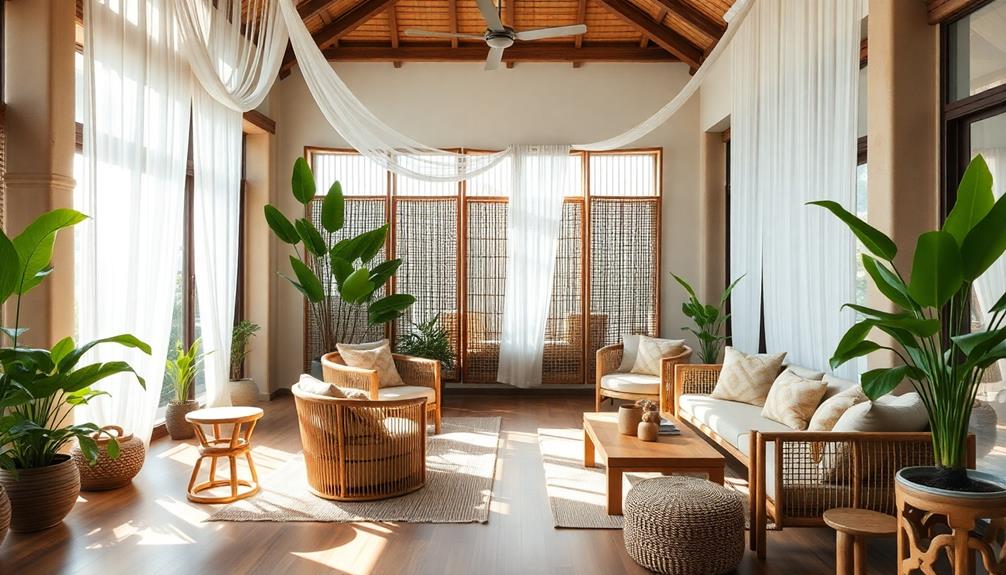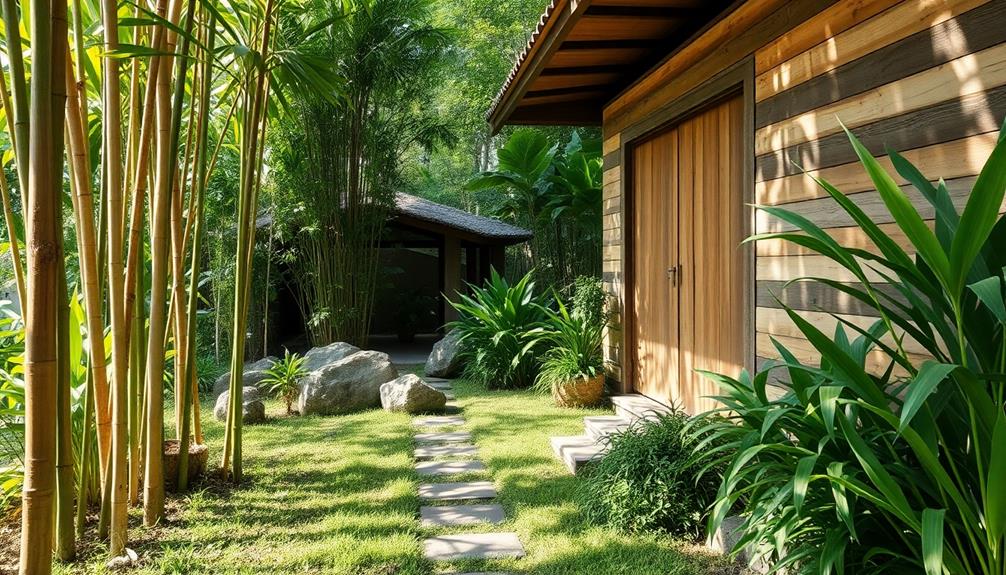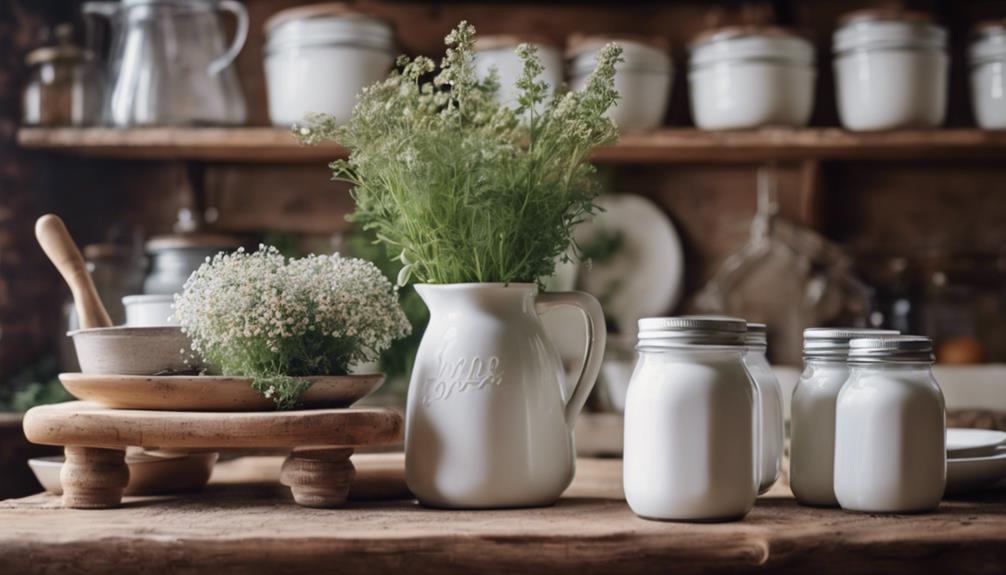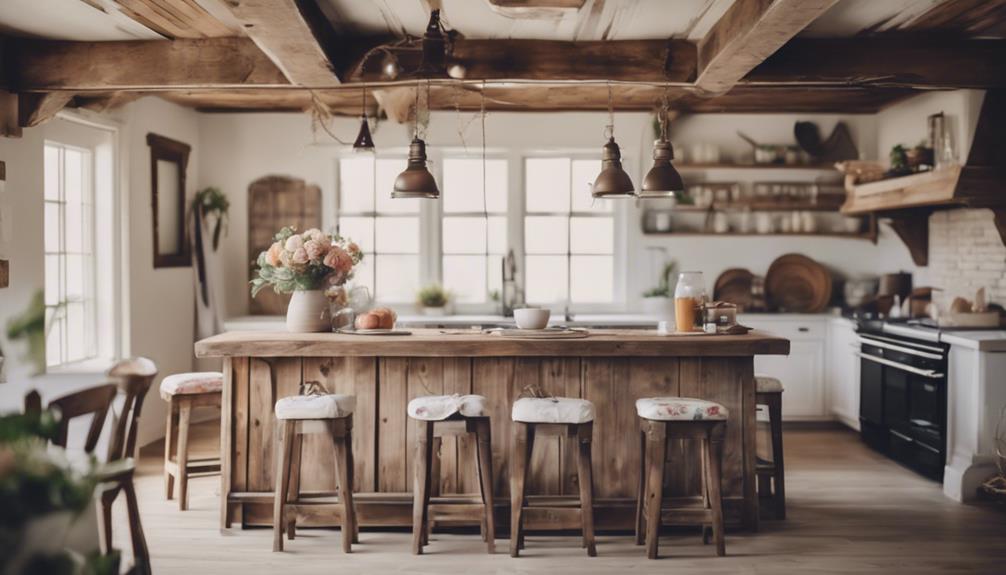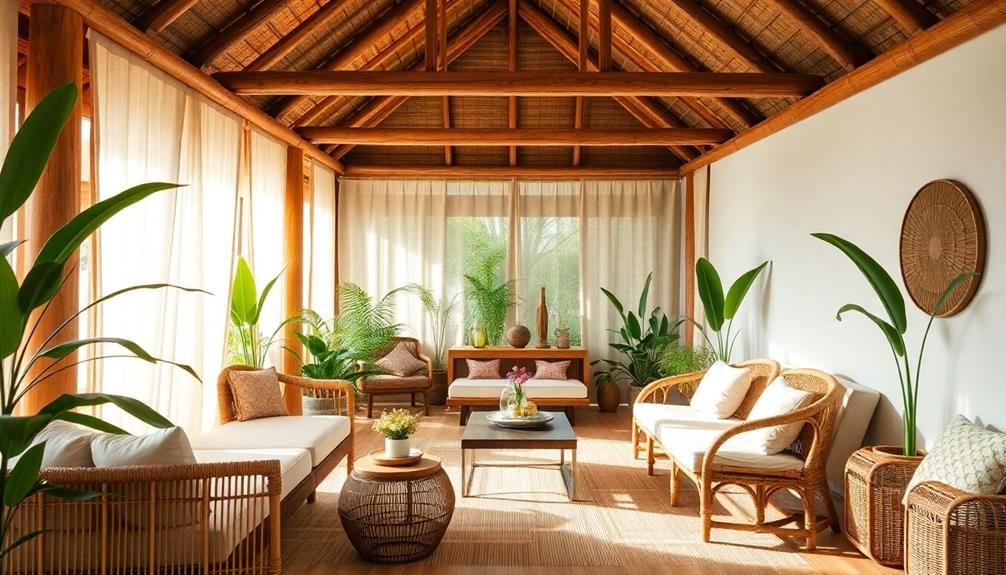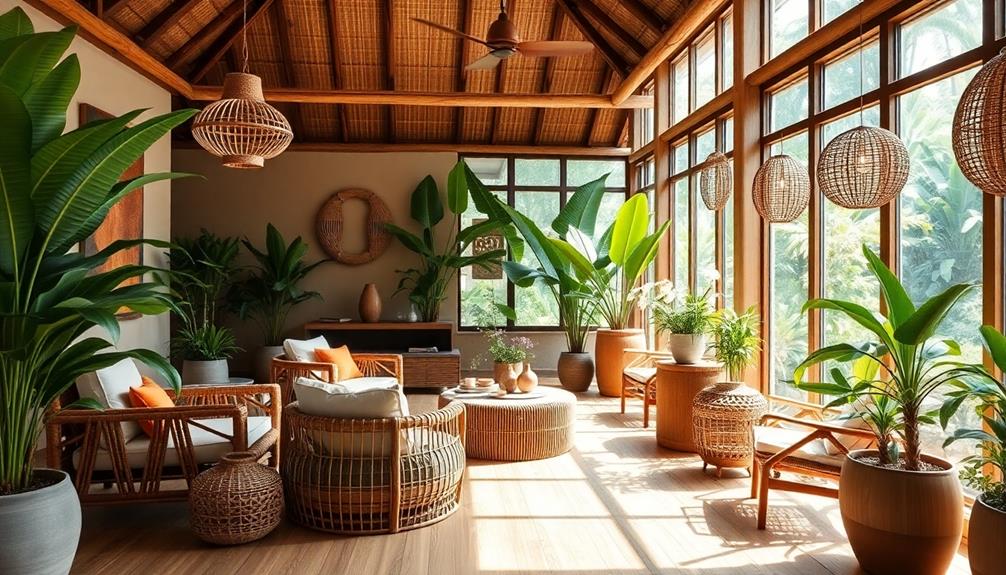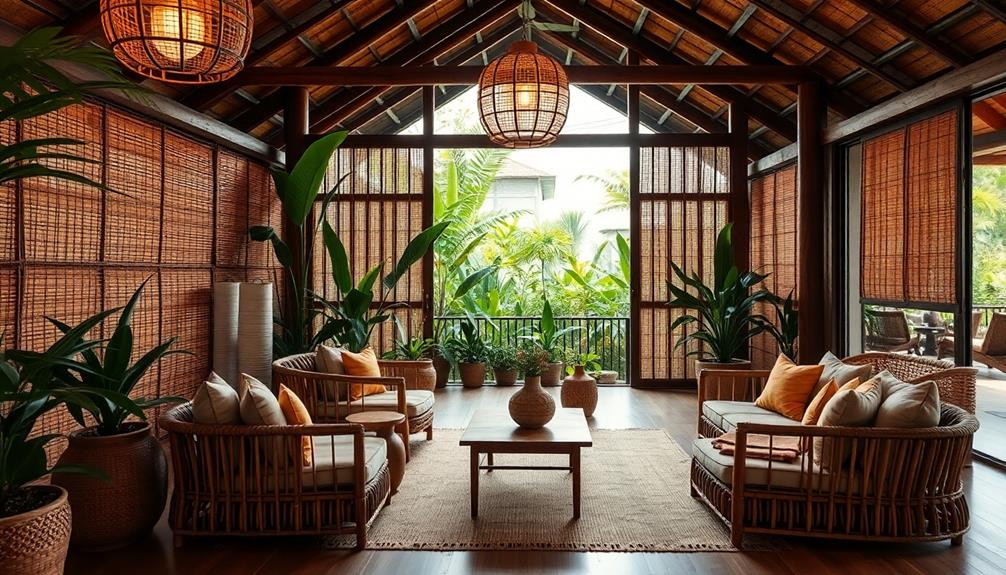When designing your Indonesian interior, consider these 10 sustainable materials. Bamboo is a fast-growing plant, perfect for flooring and furniture. Recycled plastic minimizes waste, while reclaimed wood tells a story and reduces deforestation. Coconut and teak wood offer unique aesthetics and durability. Thatch roofing provides excellent insulation and supports local craftsmanship. Natural fibers like rattan and jute are versatile and eco-friendly. Stone enhances beauty and regulates temperature. Finally, biocomposite materials combine natural fibers and polymers, promoting local sourcing. Explore these options, and you'll discover how they seamlessly tie together sustainability and style in your spaces.
Key Takeaways
- Bamboo is a fast-growing, renewable resource ideal for flooring and furniture, with a low carbon footprint.
- Recycled materials, such as plastic and reclaimed wood, promote sustainability by minimizing waste and preserving natural resources.
- Natural wood alternatives like coconut and teak wood offer durability, aesthetic appeal, and support local economies.
- Thatch roofing features excellent insulation, cultural significance, and eco-friendliness, lasting up to 30 years with proper maintenance.
- Natural fibers like rattan and jute are biodegradable, durable, and enhance home decor while supporting sustainable practices.
Bamboo
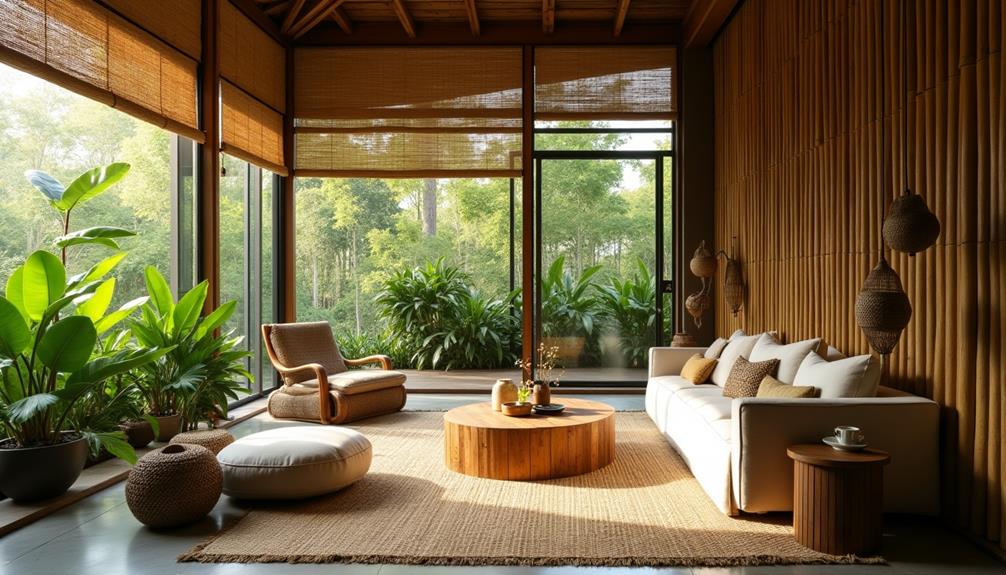
Have you ever considered how bamboo can transform your interior space? This remarkable plant is one of the fastest-growing species in the world, capable of shooting up to 1.5 inches per hour. This rapid growth makes bamboo a highly renewable resource, perfect for sustainable materials in your home.
Its natural strength and flexibility allow for diverse applications, whether you're looking to install durable flooring, stylish furniture, or structural supports in a modern Indonesian design. Furthermore, bamboo seamlessly integrates with Balinese design characteristics, emphasizing sustainability and a connection to nature.
Using bamboo contributes to eco-friendly building practices, as it has a low carbon footprint and requires minimal energy for processing compared to traditional hardwoods. Additionally, incorporating bamboo in your interior not only supports sustainability but also boosts local economies, benefiting artisans and farmers who rely on bamboo cultivation.
The unique aesthetic qualities of bamboo—its natural texture and color variations—can enhance your living space while aligning with biophilic design principles. By choosing bamboo, you're not just making a design choice; you're embracing a lifestyle that values sustainability and a connection to nature.
Recycled Plastic
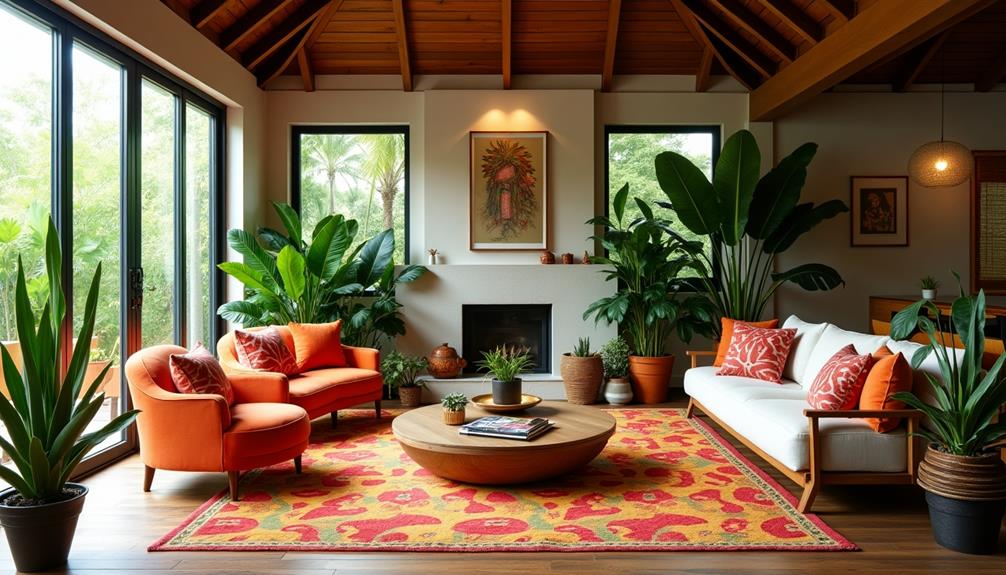
Recycled plastic is a game changer for reducing environmental impact in interior design.
By incorporating vibrant colors and intricate patterns found in Indonesian Decorative Pillows, you can create innovative and stylish spaces while tackling plastic waste, transforming it into functional furniture and decor.
Environmental Impact Reduction
Sustainability in interior design hinges on innovative solutions that tackle the plastic waste crisis. By using recycled plastic materials, you can greatly reduce reliance on virgin resources and lessen the environmental impact of your designs.
This approach not only addresses local waste issues but also aligns with sustainable development goals, promoting eco-friendly practices. Additionally, incorporating elements of traditional artistry, such as Indonesian decor masks, can further enhance your designs while celebrating cultural heritage.
Here are three ways recycled plastics can help in environmental impact reduction:
- Minimized Waste: By incorporating recycled plastics, you actively reduce the amount of plastic waste that ends up in landfills and oceans, contributing to a cleaner environment.
- Circular Economy: Using sustainable materials like recycled plastics supports the concept of a circular economy, where resources are reused and repurposed, minimizing the depletion of natural resources.
- Longevity of Products: Effective recycling processes enhance the durability of interior products. This means your designs last longer, leading to less frequent replacements and reducing overall waste in the industry.
Innovative Design Applications
In the domain of interior design, innovative applications of recycled plastic are reshaping the landscape of sustainable materials. By transforming plastic waste into durable and aesthetic components, you can address the global plastic crisis while promoting sustainability in Indonesia. This approach not only enhances the longevity of your interior products but also aligns with sustainable design principles.
Furthermore, integrating unique cultural decor, such as Indonesian decor masks, can further enrich the design narrative, showcasing the blend of tradition and modernity.
Research shows that incorporating recycled plastics fosters creative solutions to waste management, emphasizing both functionality and style. You'll find that these materials can minimize landfill contributions and open doors to new, eco-friendly design trends. As you explore these options, you'll resonate with environmentally conscious consumers who value sustainability.
Collaborative efforts among designers and material scientists are key to developing high-quality recycled plastic products. By working together, you can enhance the visibility and acceptance of sustainable materials in Indonesian interior design.
This synergy allows you to create beautiful spaces while making a positive impact on the environment. Embracing recycled plastic not only revolutionizes your design approach but also contributes to a more sustainable future for all.
Coconut Wood
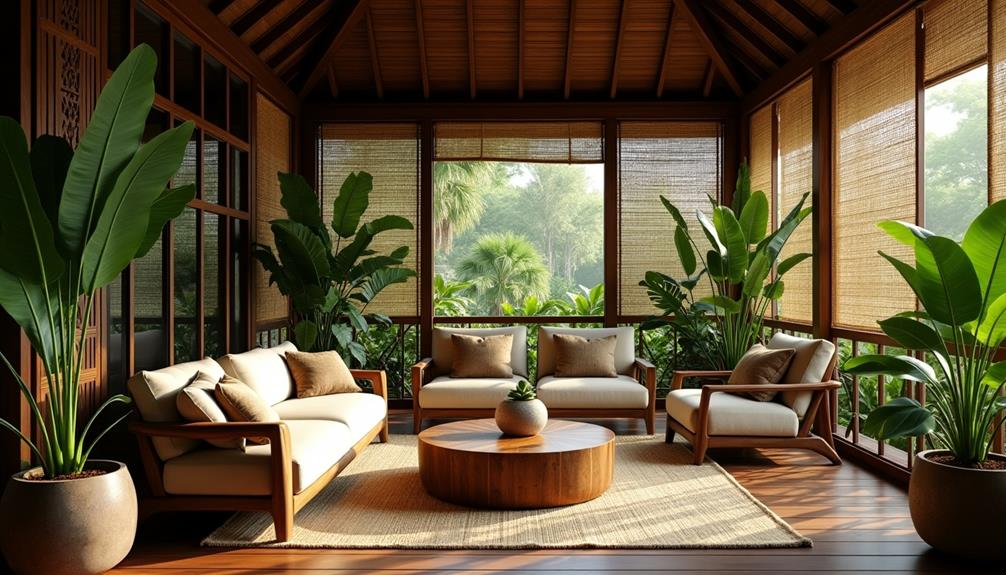
Coconut wood offers a sustainable alternative to traditional hardwoods, making it a smart choice for eco-conscious design.
Traditional Indonesian housing often utilizes local materials like wood, which highlights the importance of sourcing sustainable options in modern applications.
Its unique grain and durability make it perfect for a variety of interior applications, from furniture to decorative accents.
Sustainability Benefits of Coconut
When considering eco-friendly options for interior design, coconut wood stands out as a remarkable choice. This sustainable material repurposes aging coconut palm trees that no longer produce fruit, effectively reducing waste and minimizing environmental impact.
Incorporating coconut wood into your design not only enhances the aesthetic appeal, but also aligns with the principles of traditional Indonesian style home decor that emphasize harmony with nature.
Here are three key sustainability benefits of coconut wood:
- Natural Aesthetics: With its unique grain patterns and rich color, coconut wood adds beauty to any space, enhancing the overall design while being a natural material.
- Durability: It's naturally resistant to pests and decay, which means you'll enjoy lower maintenance costs and a longer lifespan for your furnishings.
- Supporting Local Economies: By using coconut wood, you're not just making a sustainable choice; you're also supporting local communities in Indonesia that rely on this resource for their livelihood.
Moreover, coconut wood has a lower carbon footprint compared to conventional timber.
Choosing coconut wood for your interior design needs helps you prioritize sustainable practices, making a positive impact on both the environment and local economies.
Embracing this natural material is a step toward a greener future in design.
Applications in Interior Design
Transforming spaces with coconut wood offers a unique blend of sustainability and aesthetic appeal. As you explore interior design options, consider using this sustainable material for furniture and flooring.
Coconut wood, a byproduct of aging coconut palms, not only helps reduce waste in the coconut industry but also adds a distinct character to your projects. Its unique grain and color variations create a visual interest that can enhance any room, making it a popular choice among luxury tropical designs.
Incorporating coconut wood into your designs means you're choosing a naturally durable material that resists pests, minimizing the need for harmful chemical treatments. This choice contributes to healthier indoor environments, which is essential for well-being.
Plus, the low carbon footprint of coconut wood aligns well with eco-friendly design principles, making it a responsible choice.
Teak Wood
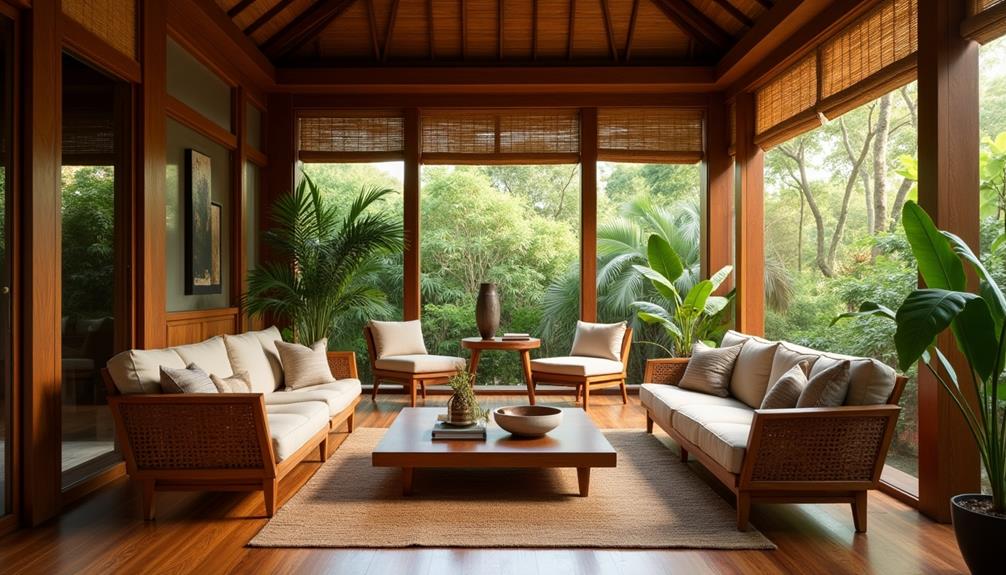
Teak wood stands out as a premier choice in Indonesian interior design due to its remarkable strength and durability, making it perfect for both indoor and outdoor applications.
As you explore sustainable architecture, teak wood emerges as an ideal building material that not only satisfies aesthetic desires but also supports eco-friendly practices.
In addition to its physical attributes, teak wood is often used in traditional Indonesian housing, reflecting the cultural significance of local materials in design. This connection to heritage enhances its value, as noted in the aspect of traditional Indonesian housing that emphasizes regional identity.
Here are three compelling reasons to contemplate teak wood in your design projects:
- Natural Resistance: The natural oils in teak provide resistance to weather and pests, reducing the need for harmful chemical treatments that could compromise your indoor air quality.
- Aesthetic Appeal: Teak wood's rich golden-brown color and unique grain patterns can enhance any interior space, aligning perfectly with sustainable design principles and creating a warm, inviting atmosphere.
- Sustainable Sourcing: Teak is often harvested using sustainable practices from responsibly managed forests, ensuring that your choice contributes to environmental conservation efforts.
As you incorporate teak wood into your designs, you not only embrace a beautiful building material but also contribute to a growing trend of sustainable living in Indonesia.
Thatch Roofing

Thatch roofing offers a unique blend of traditional aesthetics and sustainability, making it a smart choice for your interior design projects.
Its connection to Bali Roof Style promotes local craftsmanship, enriching the cultural identity of your space.
You'll appreciate its excellent insulation properties, which enhance energy efficiency while minimizing environmental impact.
Plus, with proper maintenance, these roofs can last up to 30 years, supporting local craftsmanship and economies along the way.
Benefits of Thatch Roofing
Choosing thatch roofing for your home offers a range of benefits that align with sustainable living. This natural option not only enhances your sustainable interior but also serves as an eco-friendly building material. Incorporating traditional materials such as thatch can enrich the overall aesthetic of your home, much like incorporating vibrant color palettes in Indonesian wedding decor.
Here are three compelling advantages of thatch roofing:
- Excellent Insulation: Thatch roofing, made from straw, reeds, and palm leaves, provides outstanding insulation. It helps maintain comfortable indoor temperatures, which can greatly reduce your energy costs.
- Biodegradable and Eco-Friendly: As a biodegradable choice, thatch roofing integrates seamlessly into the environment, minimizing waste. This feature supports sustainable building practices in Indonesia, making it a responsible option for your home.
- Versatile Aesthetic: Thatch roofing enhances the aesthetic appeal of traditional Indonesian architecture. Its lightweight and flexible nature allows for easy installation and adaptation to various architectural styles, promoting both cultural heritage and eco-friendly design.
With proper maintenance, thatch roofing can last up to 25 years, providing a durable and sustainable roofing solution that complements your commitment to environmentally conscious design principles.
Traditional Aesthetics and Sustainability
Incorporating thatch roofing into your home design not only celebrates Indonesia's rich cultural heritage but also embraces sustainability. This natural building technique utilizes straw, reeds, and palm leaves, creating an environmentally friendly option that insulates your home effectively. Thatch roofs harmonize beautifully with the surrounding environment while showcasing traditional craftsmanship, connecting you to Indonesia's past.
| Feature | Benefits | Aesthetic Appeal |
|---|---|---|
| Natural Materials | Biodegradable & sustainable | Warm, rustic look |
| Energy Efficiency | Reduces energy costs | Unique texture & style |
| Cultural Heritage | Promotes identity | Traditional craftsmanship |
| Eco-Friendly Design | Low ecological footprint | Blends with nature |
Installation and Maintenance Tips
When considering thatch roofing for your home, proper installation is essential to secure its longevity and effectiveness.
Thatch roofs, made from straw, reeds, or palm leaves, provide excellent insulation and are biodegradable, making them a great eco-friendly choice. In traditional Indonesian architecture, these roofs are often integral to the design, reflecting the cultural heritage of the region and promoting sustainability through the use of natural materials traditional housing structures.
To guarantee peak performance, follow these installation and maintenance tips:
- Install at a 45-Degree Pitch: Layer the thatch with a minimum pitch of 45 degrees. This angle promotes effective water runoff and prevents leaks, protecting your investment.
- Conduct Regular Inspections: Perform maintenance checks at least twice a year. Look for signs of mold or deterioration to catch issues early and extend the lifespan of your thatch roof, which can last between 15 to 30 years with proper care.
- Utilize Local Materials: Using locally sourced thatch not only supports regional economies but also promotes traditional craftsmanship, enriching Indonesian architecture.
Rammed Earth
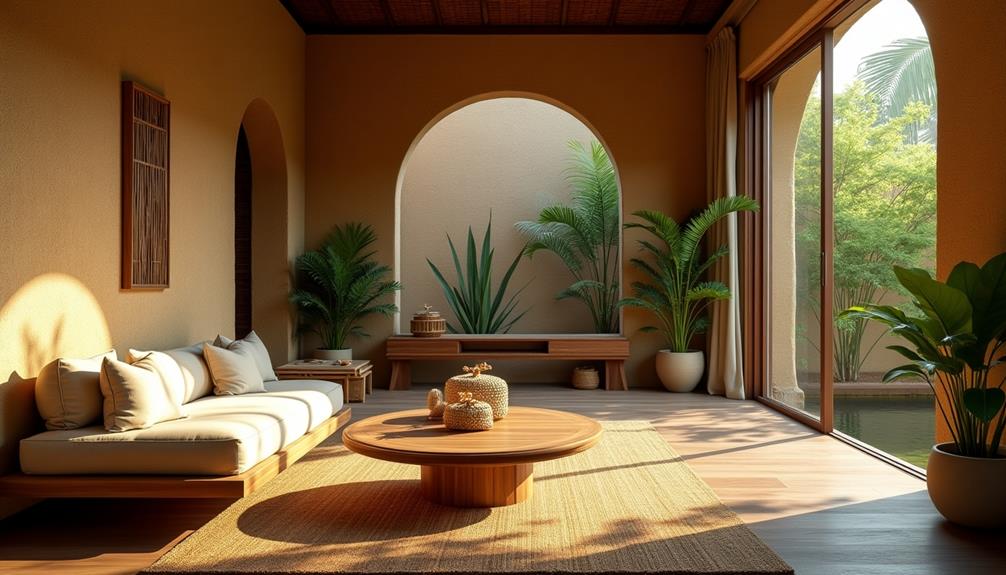
Rammed earth's unique combination of soil, sand, and gravel creates solid walls that not only enhance a building's thermal mass but also contribute to its energy efficiency. This sustainable construction method has been practiced for centuries, and it's making a comeback, especially in Indonesia, where locally sourced materials can be utilized effectively.
By opting for rammed earth, you're choosing a low-impact building technique that respects the environment while offering durability.
With a lifespan of over 100 years, rammed earth walls provide a long-lasting option for your interior design needs. The natural aesthetic, featuring unique textures and colors, can elevate your space, making it visually appealing compared to conventional building materials.
Plus, this approach helps reduce your carbon footprint by minimizing the use of energy-intensive materials like concrete and steel, aligning with sustainable development goals.
Incorporating rammed earth into your projects not only supports eco-friendly practices but also enhances the overall design.
Natural Fibers
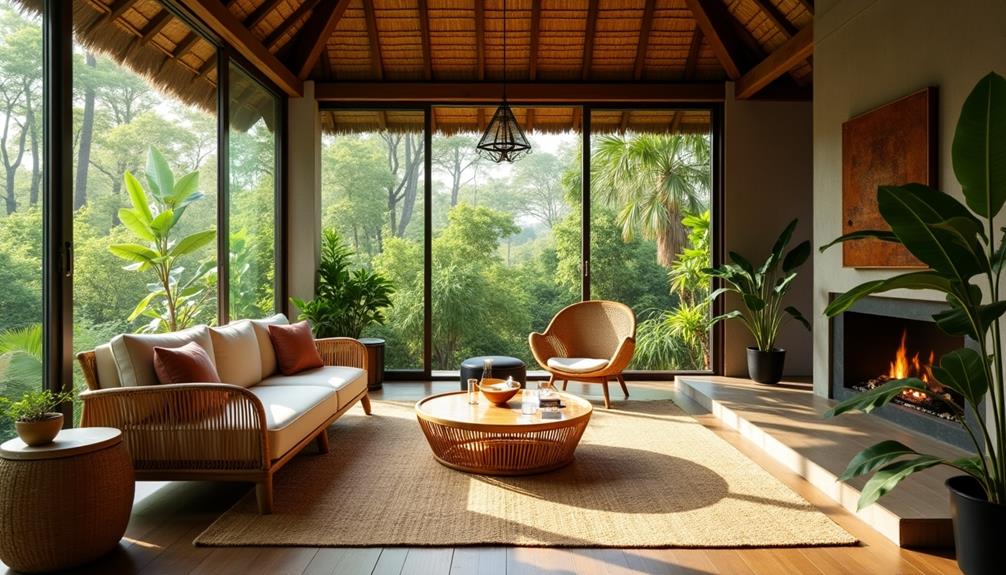
Natural fibers like rattan, bamboo, and jute are transforming Indonesian interior design with their renewability and aesthetic charm.
By utilizing these sustainable materials, you're not just enhancing your space; you're also supporting the environment. Incorporating natural resources into your design can create a warm and inviting atmosphere while reducing your ecological footprint.
Here are three reasons to evaluate natural fibers in your interior projects:
- Versatility of Rattan: Rattan is a fast-growing palm that can be crafted into various furniture pieces, making it an excellent choice for both function and style.
- Strength of Bamboo: With its rapid growth rate of up to 1.5 inches per day, bamboo serves as a strong building material that contributes to low carbon emissions, perfect for eco-conscious designs.
- Durability of Jute: Known for its durability and low environmental impact, jute is ideal for textiles and carpets, promoting sustainable practices in your home.
Reclaimed Wood
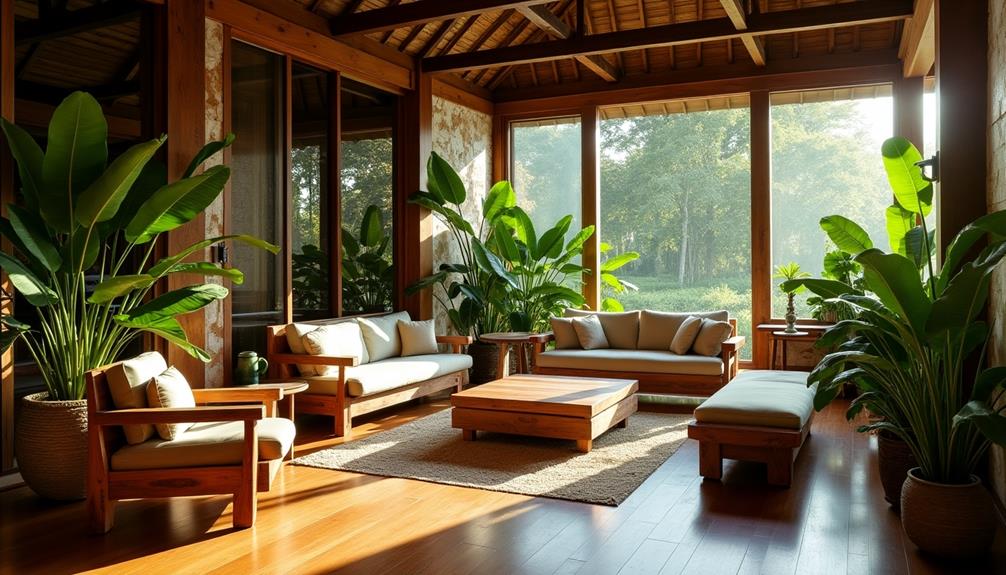
Embracing reclaimed wood in your interior design not only showcases unique character but also champions sustainability. By choosing reclaimed wood, you're opting for timber salvaged from old buildings and furniture, greatly reducing the need for new lumber and minimizing deforestation. This choice lowers your carbon footprint, as it cuts down on the production and transportation emissions associated with new materials.
In Indonesia, reclaimed wood often originates from traditional structures, allowing you to preserve cultural heritage while achieving a distinctive, weathered aesthetic in your space. This integration of historical elements enriches your interior design, making it a conversation starter.
Moreover, reclaimed wood is recognized for its durability and strength, often proving more resilient than new wood, which makes it a practical choice for your sustainable interior design projects.
You'll also benefit from improved indoor air quality, as reclaimed wood typically has lower levels of volatile organic compounds (VOCs) compared to processed wood products.
Incorporating reclaimed wood not only enhances your living space but also supports a healthier environment, reflecting your commitment to sustainability and appreciation for cultural heritage.
Stone
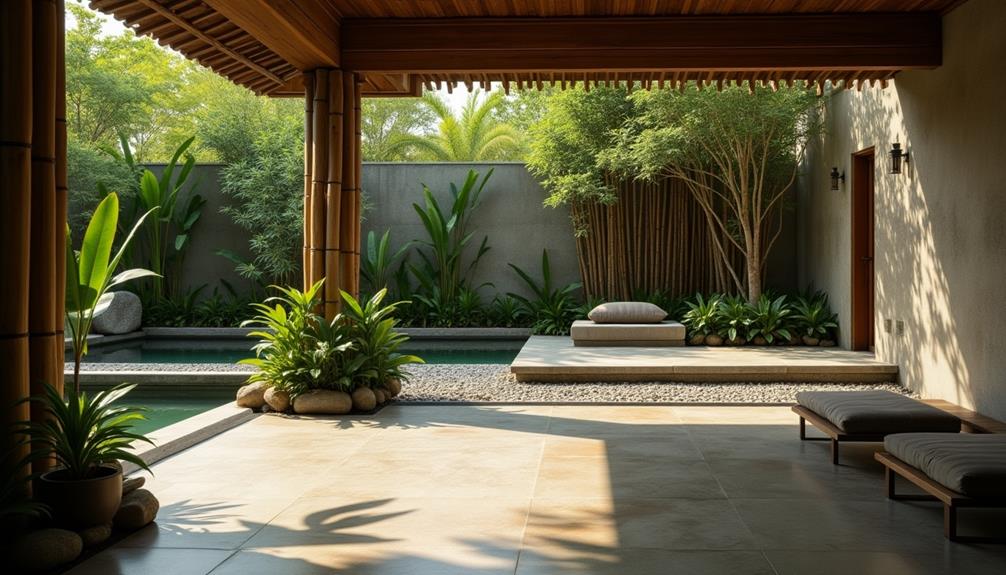
After exploring the charm of reclaimed wood, consider how stone can elevate your Indonesian interior design. This sustainable material isn't only durable but also brings aesthetic elegance and structural integrity to your spaces.
Indonesian stones like andesite and basalt are locally sourced, cutting down on transportation emissions and supporting eco-friendly practices.
Here are three reasons to incorporate stone into your design:
- Thermal Mass: Stone helps regulate indoor temperatures, minimizing your reliance on artificial heating and cooling.
- Versatility: You can use stone for various applications, from flooring to wall cladding, making it suitable for both residential and commercial spaces.
- Natural Connection: Using stone aligns with biophilic design principles, offering natural textures and colors that create a calming atmosphere.
Moreover, stone materials can be treated to enhance their resistance to moisture and wear, making them ideal for high-traffic areas.
Biocomposite Materials
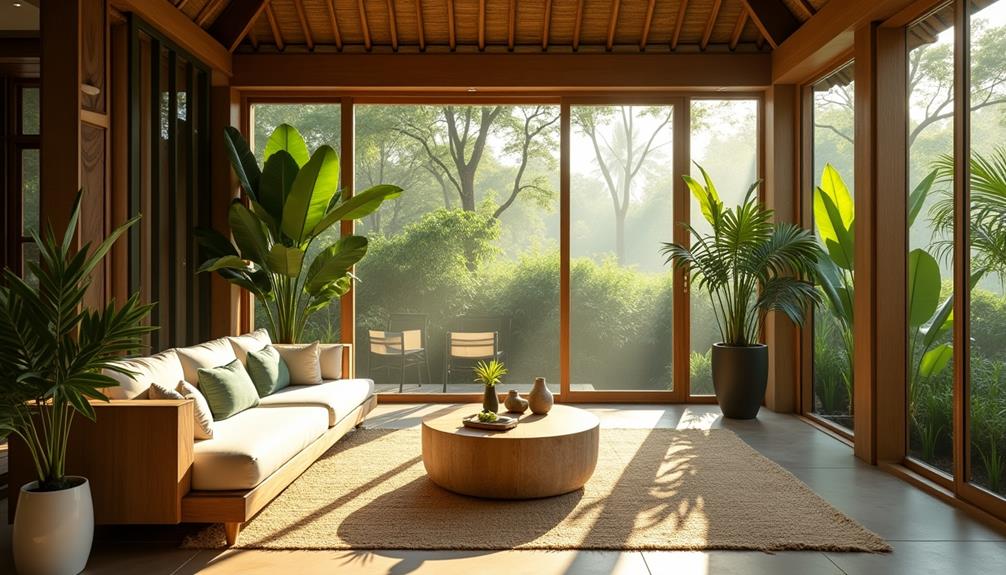
Incorporating biocomposite materials into your Indonesian interior design can markedly enhance sustainability while adding unique character to your spaces. These materials are crafted from a blend of natural fibers and polymers, offering an eco-friendly alternative that reduces your reliance on traditional synthetic options. Commonly used fibers like bamboo, rattan, and kenaf are abundant in Indonesia, supporting sustainable sourcing practices and local economies.
Using biocomposite materials not only contributes to a reduced ecological footprint but also considerably lowers carbon emissions. Their enhanced mechanical properties, such as increased strength and durability, make them ideal for various applications, from furniture to architectural elements.
Imagine the beauty of handcrafted furniture that's both strong and sustainable, creating a warm, inviting atmosphere in your home.
Ongoing research and development in biocomposite technologies are focused on improving performance and affordability, promoting wider adoption in the Indonesian market. By choosing biocomposite materials, you're not just making a design choice; you're embracing a lifestyle that values environmental responsibility and innovation.
Frequently Asked Questions
What Fabrics Are Sustainable Interior Design?
For sustainable interior design, you can choose organic cotton, linen, hemp, recycled polyester, or Tencel. Each fabric offers eco-friendly benefits, like reduced water usage and lower environmental impact, making your space stylish and responsible.
What Are Some Examples of Sustainable Materials That Can Be Used in Industrial Design?
You wouldn't believe it, but using bamboo in industrial design is quite revolutionary! You'll find rattan, coconut wood, plywood, and thatch roofing also make sustainable choices, blending functionality with eco-friendliness. Embrace these materials for better designs!
What Are the Materials for Sustainable Architecture?
In sustainable architecture, you'll find bamboo, teak wood, thatch roofing, coconut wood, and karuun®. Each material not only minimizes environmental impact but also enhances aesthetic appeal, durability, and functionality in your design projects.
How Do Interior Designers Use Sustainability?
You'll find interior designers using sustainability by selecting eco-friendly materials, promoting biophilic design, and creating adaptable spaces. They focus on reducing waste, supporting local economies, and enhancing well-being through a deeper connection with nature.
Conclusion
By incorporating sustainable materials like bamboo or reclaimed wood into your Indonesian interior design, you're not just enhancing aesthetics but also promoting eco-friendliness. Imagine a cozy living room featuring bamboo furniture and a reclaimed wood coffee table, creating a warm, inviting atmosphere while reducing your carbon footprint. This blend of style and sustainability not only showcases your commitment to the environment but also inspires others to reflect on the impact of their design choices.
